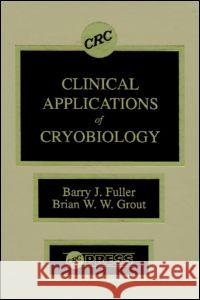Clinical Applications of Cryobiology » książka
Clinical Applications of Cryobiology
ISBN-13: 9780849354298 / Angielski / Twarda / 1991 / 256 str.
This book presents a state-of-the-art summary of the applications of low temperature to clinical situations, together with details of the underlying principles of biology. It provides specific information for the clinicians and research workers in a number of areas of current interest and attempts to provide a unifying theme of cryobiology of interest and value to those researching a clinical problem. Specific topics discussed include the effects of low temperatures on mammalian systems in the absence of ice and how the changes can be modulated to achieve desired results; low temperature storage of tissues and organs for transplantation in the liquid state; the effects of whole body hypothermia in man and how it relates to mammal hibernation; problems associated with ice formation and the subsequent freezing of cells and tissues; cryopreservation of blood cells, reproductive cells, and tissues, such as the skin and cornea. Other interesting issues featured include the developments in cryopreservation of large, highly-organized structures and the destructive powers of ice formation in cryosurgery of diseased tissues.
This book presents a state-of-the-art summary of the applications of low temperature to clinical situations, together with details of the underlying principles of biology. It provides specific information for the clinicians and research workers in a number of areas of current interest and attempts to provide a unifying theme of cryobiology of interest and value to those researching a clinical problem. Specific topics discussed include the effects of low temperatures on mammalian systems in the absence of ice and how the changes can be modulated to achieve desired results; low temperature storage of tissues and organs for transplantation in the liquid state; the effects of whole body hypothermia in man and how it relates to mammal hibernation; problems associated with ice formation and the subsequent freezing of cells and tissues; cryopreservation of blood cells, reproductive cells, and tissues, such as the skin and cornea. Other interesting issues featured include the developments in cryopreservation of large, highly-organized structures and the destructive powers of ice formation in cryosurgery of diseased tissues.











